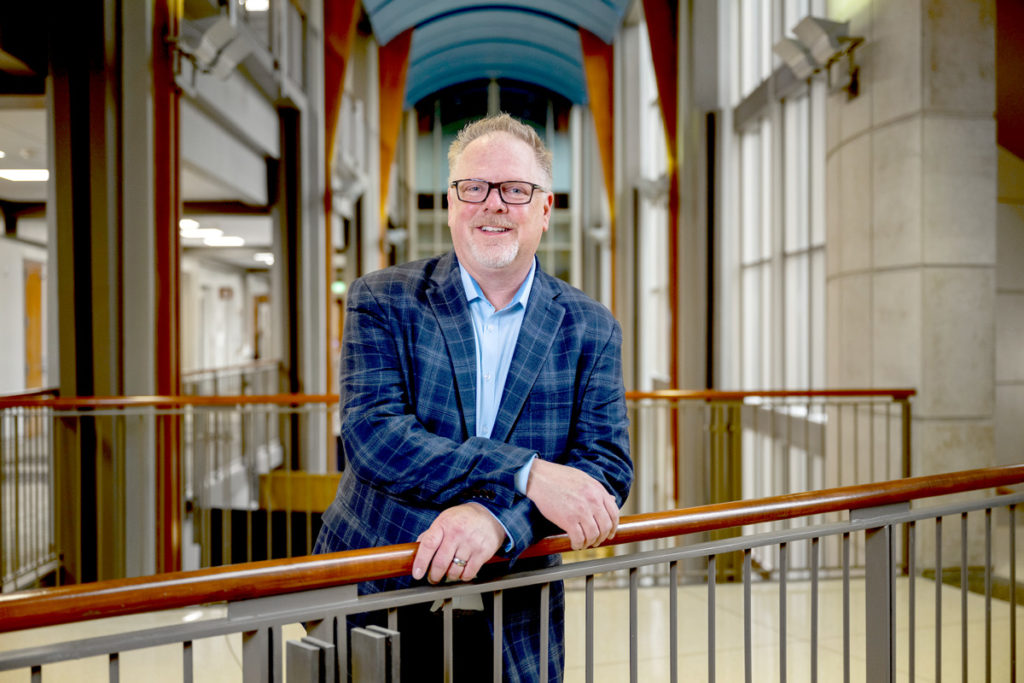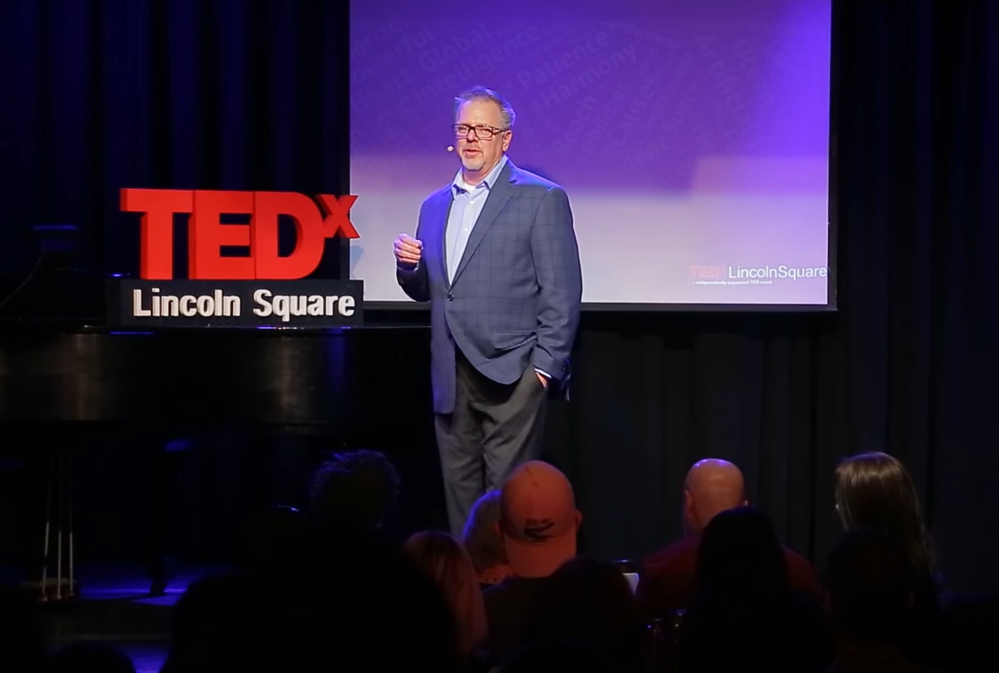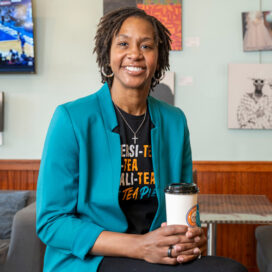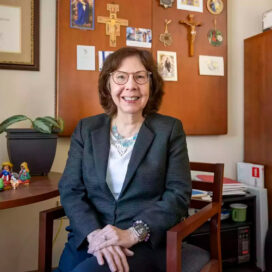Cracking the Code on Generosity: Nathan Chappell
Published: September 26, 2021 / Author: Heather Grennan Gary

Nathan Chappell
Americans are known worldwide for their generosity, but studies show American generosity is eroding. A recent report from the Generosity Commission points out that 20 million fewer American households make philanthropic donations today compared to the year 2000. This development is bad news for nonprofits that rely on these gifts to accomplish their work. But Nathan Chappell (MNA ’07) champions a surprising tool that is infusing new life into American philanthropy: artificial intelligence.
Chappell is senior vice president of DonorSearch Aristotle, the research division of DonorSearch that uses AI to help nonprofits find more predictive and strategic donor prospects. Previously, he spent two decades working for large nonprofits in health care and higher education. Throughout his career, Chappell has puzzled over what factors inspire people to give. Ultimately, studies point to one reason: people give because of experiences.
“Engagement is the number one thing that drives philanthropy,” he says. That means the traditional strategy nonprofits have used since the 1980s to find prospective donors—prioritizing someone’s wealth—will do little to stop the decline in generosity. “It never sat well with me that nonprofit strategies were focused on rich people,” Chappell says. “I figured there had to be a better way.”
With this in mind, about five years ago he began to research machine learning, a branch of artificial intelligence. Companies such as Amazon, Google and Netflix had already been successfully implementing AI for years, but very few nonprofits had tested the AI waters at that point. In part, this was due to the high cost of setting up and deploying AI. But it was also due to the fact that nonprofits are typically slow to innovate, and there wasn’t clear evidence about how AI could help nonprofits increase engagement and giving.
Chappell decided to assemble a team of data scientists and statisticians to build a machine-learning model that would allow health care organizations to use AI in their fundraising efforts. After 18 months, they had a model that worked. In addition to considering standard fundraising data including someone’s wealth, the model considered the number of visits a patient made, which departments they visited and which clinicians they saw. (HIPAA prohibits fundraisers from using data related to diagnosis, treatment or outcome.) “We were looking for people who’d had really life-changing, meaningful experiences,” Chappell says.
The results were illuminating. They found that the new data — which departments and clinicians a patient visited, and how many times — correlated strongly with whether someone would make a gift. A patient’s wealth, on the other hand, was only 10% indicative of whether they would give. “This debunked the whole idea that wealth should be the primary way to look for new donors, and that’s been a breath of fresh air for the nonprofit community,” says Chappell.

TEDxLincolnSquare talk “Artificial Intelligence and the Future of Generosity” by Nathan Chappell
Since then, Chappell has been eager to highlight AI’s promise for the nonprofit sector. In 2018, he presented a TEDx talk on AI and the future of generosity, and in 2021 he presented an OSV Talk (Our Sunday Visitor) that focused specifically on philanthropic giving and religion. He uses the phrase “precision philanthropy,” a name that evokes precision medicine. Just as precision medicine uses AI to interpret large amounts of a patient’s health and genetic data to determine the best treatment, precision philanthropy uses AI to interpret large amounts of data about someone to determine their likelihood of giving to a particular organization at a particular time.
This strategy has been effective, Chappell says. “When nonprofit organizations move to our AI model, they typically outperform their previous fundraising efforts by four to five times if they’ve been relying on wealth data alone to identify patient donors.”
While their original model was built for health-care fundraisers, Chappell and his team next moved to help fundraisers in higher education implement precision philanthropy. Schools have ample data on their alumni, everything from which classes they took with which professors, whether they lived on campus, how long it took them to graduate, even the number of campus parking tickets received and the number of football games attended. And after graduation, schools continue to track fundraising contributions, alumni event attendance, email opens — all significant clues that help organizations tailor, refine, and personalize their messaging for a particular person.
Other types of nonprofits are also beginning to move in the direction of precision philanthropy. In his OSV talk, Chappell uses the example of animal charities that traditionally thought of their donors as animal lovers. With precision philanthropy, the organization can ascertain important details to make their fundraising communications more compelling. Is someone a dog person or a cat person? “The reality is, people are very polarized on this issue,” Chappell says. They either like dogs or they like cats — and whichever they like, they often dislike the other. “AI can really help create a customized roadmap to our philanthropic journey,” he adds.
Using AI to help grow generosity has come a long way in a short time. While his first model took 18 months to build, it now takes less than a month to build a much more powerful and accurate one. Five years ago, machine learning was only available to large-scale nonprofits that could afford to innovate. Just a year ago, the cost of a single AI deployment was $15,000; now it’s $1,500. This means he’s able to work with smaller and smaller organizations all the time.
Despite the level of promise that AI holds for the sector, Chappell recognizes some big potential pitfalls that nonprofits need to avoid. “Trust is the currency of philanthropy,” he says. “If there’s a security breach or question about how an organization is using someone’s data, it diminishes the trust in the sector as a whole.” In August, he convened the first meeting of Fundraising.ai, a group of about 50 thought leaders in AI and philanthropy to discuss questions of privacy, security and ethics. The group’s mission is to develop best practices for the use of AI in philanthropy and to conduct research on the subject.
Chappell has big dreams for the future of generosity and the role AI will have in it. In his OSV Talk, he explains how, for decades, philanthropic giving in the U.S. has consistently accounted for 2.1% of the GDP. By increasing that a single percentage point to 3.1%, the nonprofit sector would receive an additional $200 billion per year to carry out its important work. AI is the not-so-secret advantage that could turbocharge giving, and — just as importantly — connect individual givers, regardless of their wealth, with nonprofit organizations that are doing work they want to support.
“In the end, while many want to think about AI raising more money, it’s actually about creating enormous efficiencies for nonprofits that allow those who use the AI to work at a higher, more strategic level,” Chappell says. AI can light the way, but at this point, it’s still up to humans to create a more generous society.




